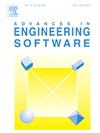Stochastic vibration mechanisms in irregular coupled plate of supersonic porous functionally graded materials with temperature gradients
IF 5.7
2区 工程技术
Q2 COMPUTER SCIENCE, INTERDISCIPLINARY APPLICATIONS
引用次数: 0
Abstract
The porous irregular functional gradient material (FGM) coupled plates, composed of two arbitrary quadrilateral plates coupled at any angle, are widely used in aerospace applications and equipment such as hypersonic vehicles. This paper investigates the stochastic response mechanisms of the porous irregular FGM coupled plate under aerothermal environments and base acceleration excitations. Three typical geometric models are established to validate the universality of the present method. The equations derived from supersonic piston theory and Mindlin plate theory incorporate temperature-dependent material properties. Subplate displacements are approximated using the first-kind Chebyshev polynomials, with irregular domain integrals resolved through coordinate transformations. Sufficient comparisons with the finite element method (FEM) and published literature confirm the accuracy and computational efficiency of this approach. The resulting systematic framework enables stochastic response analysis in analogous complex structures. Numerical discussions are conducted to analyze the effects of FGM gradient p, porosity ζ, coupling angle θ, boundary conditions, and temperature variations ΔT on the stochastic response, establishing practical tools for optimizing and conducting rapid integrity assessment of such structures.
具有温度梯度的超音速多孔功能梯度材料不规则耦合板的随机振动机理
不规则功能梯度材料(FGM)多孔耦合板是由两个任意四边形板以任意角度耦合而成的,广泛应用于航空航天和高超声速飞行器等设备。研究了不规则多孔FGM耦合板在空气热环境和基础加速度激励下的随机响应机制。建立了三个典型的几何模型,验证了该方法的通用性。由超声速活塞理论和明德林板理论导出的方程包含了与温度相关的材料特性。底板位移近似采用第一类切比雪夫多项式,通过坐标变换求解不规则域积分。与有限元法和已发表的文献进行了充分的比较,证实了该方法的准确性和计算效率。由此产生的系统框架使类似复杂结构的随机响应分析成为可能。通过数值讨论,分析了梯度p、孔隙度ζ、耦合角θ、边界条件和温度变化ΔT对随机响应的影响,建立了优化和快速完整性评估的实用工具。
本文章由计算机程序翻译,如有差异,请以英文原文为准。
求助全文
约1分钟内获得全文
求助全文
来源期刊

Advances in Engineering Software
工程技术-计算机:跨学科应用
CiteScore
7.70
自引率
4.20%
发文量
169
审稿时长
37 days
期刊介绍:
The objective of this journal is to communicate recent and projected advances in computer-based engineering techniques. The fields covered include mechanical, aerospace, civil and environmental engineering, with an emphasis on research and development leading to practical problem-solving.
The scope of the journal includes:
• Innovative computational strategies and numerical algorithms for large-scale engineering problems
• Analysis and simulation techniques and systems
• Model and mesh generation
• Control of the accuracy, stability and efficiency of computational process
• Exploitation of new computing environments (eg distributed hetergeneous and collaborative computing)
• Advanced visualization techniques, virtual environments and prototyping
• Applications of AI, knowledge-based systems, computational intelligence, including fuzzy logic, neural networks and evolutionary computations
• Application of object-oriented technology to engineering problems
• Intelligent human computer interfaces
• Design automation, multidisciplinary design and optimization
• CAD, CAE and integrated process and product development systems
• Quality and reliability.
 求助内容:
求助内容: 应助结果提醒方式:
应助结果提醒方式:


